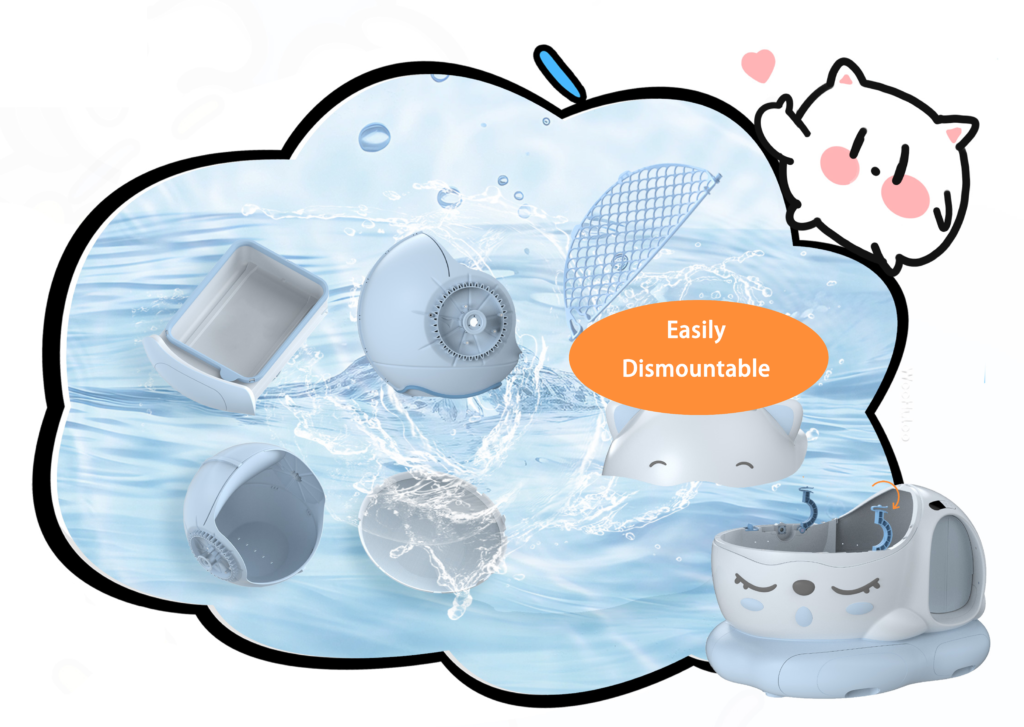Introduction
Have you ever thought about the time and hassle involved in cleaning traditional litter boxes? If you’re a pet owner, you’re probably already familiar with the frustrating task of scrubbing, taking apart parts, and dealing with messy litter. But what if we told you that the game has changed? Enter the era of the smart litter box—designed to revolutionize how we tackle this essential household chore. With cutting-edge engineering advancements, these smart boxes now promise a deep clean in just 10 minutes. Let’s dive into the engineering secrets that make this possible and transform this necessary task into a breeze!
Traditional Cleaning Challenges: Why 10 Minutes is a Breakthrough?
If you’ve ever had to tackle the infamous task of cleaning a traditional litter box, you know it can feel like an epic battle against grime and odors. The innovations leading to a 10-minute deep clean aren’t just about cutting time—they’re about redefining the entire process. Let’s dive into the challenges with traditional cleaning and why 10 minutes is truly groundbreaking.
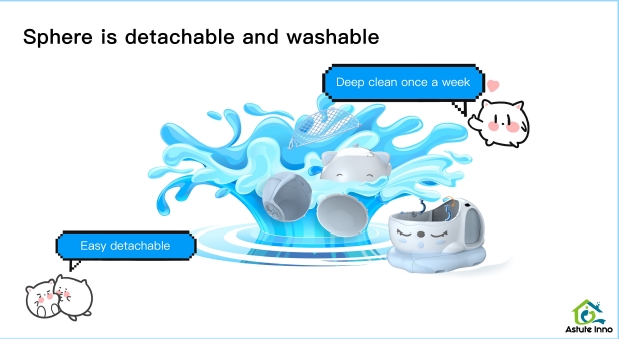
Structural Complexity & Hygiene Dead Spots
One of the biggest hurdles in cleaning traditional litter boxes involves structural complexity. Enclosed drum designs, commonly used in old-school litter boxes, harbor multiple gaps in their mesh and waste compartments. These gaps are like a five-star resort for bacteria, requiring you to dismantle upwards of 15 parts just to reach the hidden grime. That’s an average cleaning time of over 30 minutes!
Moreover, many conventional models rely on screw-fastened components. They may seem sturdy at first glance, but they bring their own set of headaches. Not only do you need tools to unscrew and reassemble them, but the threaded grooves capture waste and moisture. This creates a playground for E. coli and other nasty bacteria. Yikes!
Material Surface Energy & Contamination
When discussing litter box maintenance, what’s lurking on the surface matters more than you might think. Traditional litter boxes often use standard plastics like polypropylene (PP). This material has a high surface tension exceeding 72mN/m, which, in layman’s terms, means it easily allows urine proteins to seep in and cause those ugly, stubborn stains.
Similarly, the uncoated metal meshes found in older models can be a real hassle. Clumping litter loves to stick, blocking over 35% of the sieve pores, making cleaning almost as frustrating as an unsolvable jigsaw puzzle. These old materials almost seem like they work against you, creating more contamination than they solve!
Cleaning Efficiency Revolution: Tool-Free Snap-Fit Engineering
Thankfully, innovation has allowed us to sidestep these historical challenges with developments in tool-free snap-fit engineering. This isn’t just industry jargon; it’s what makes the revolutionary 10-minute clean possible without needing a degree in mechanical engineering.
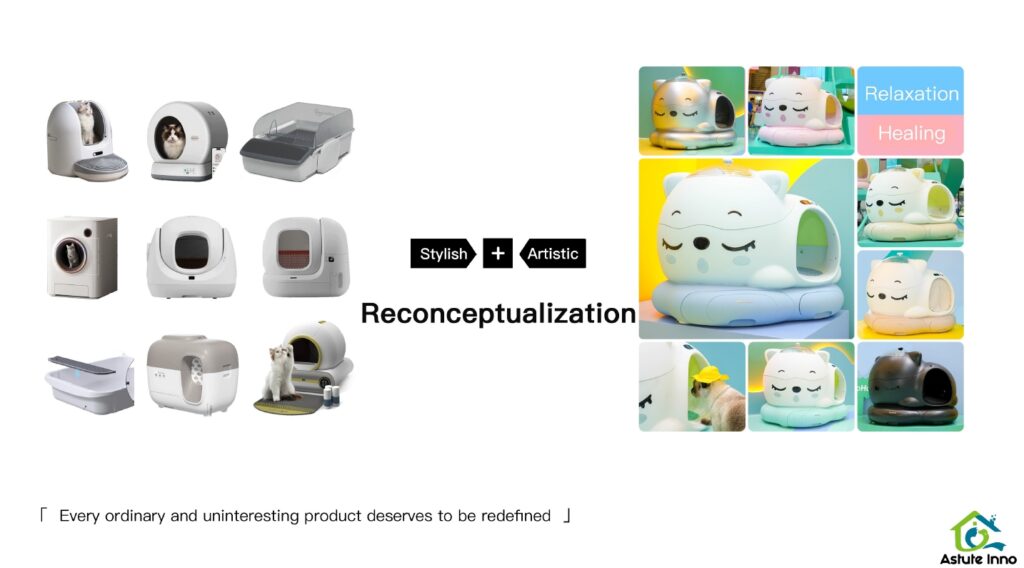
Precision Snap-Fit Mechanics
Snap-fit mechanics have changed the game by eliminating the need for tools. Picture this: a three-stage locking system where all you need is your hands. Start with a simple 45° insertion angle, let the elastic arm deform by a tiny ≥1.5mm, and then watch as the hook engages with ±0.05mm precision. All those numbers essentially mean the pieces snap together smoothly and just as easily come apart for cleaning.
Plus, these systems are built to stay in place, even with your cat’s curious antics. Anti-disengagement V-tail clasps can withstand vibrations greater than 5N, ensuring that your feline friend won’t suddenly find the litter box unceremoniously popping open during a particularly vigorous dig.
Modular Compartmentalization
The smart litter box revolution doesn’t stop at precision mechanics. Enter modular compartmentalization! Picture this feature as the ultimate ease-of-use propagator. The box is divided into independent units: a waste bin, a scoop module, and a base, all separable in three simple steps. This modular design means each part can be cleaned separately for the best results.
And when it comes to drying, efficiency is the name of the game. The parts are designed to have a 68° tilt and 12 bottom drainage holes, enabling an incredible 3-minute air-dry process. So, what does this mean for you? Faster cleaning times and better hygiene!
Here’s a quick and friendly breakdown of the process:
– Release Clasps: Initiate module separation.
– Mesh Rinse: Ensure all grime is removed.
– Waste Bin Wash: Give it a thorough clean.
– Base Wipe: Quick wipe-down to eliminate lingering mess.
After that, each part air dries before being quickly reassembled with a satisfying snap. It’s neat, it’s tidy, and you can finish up almost as quickly as your kitty can make a mess!
The leap to tool-free, snap-fit engineering and modularity has been pivotal in achieving the 10-minute clean—and in redefining litter box maintenance. Interactive, intuitive, and easy to use, this engineering marvel respects your time while giving your cat a clean and safe place to do their business. Welcome to the future of cat care.
Anti-Fouling Materials: From Passive to Active Defense
Hey there, fellow cat parents! If you’re tired of spending ages cleaning your feline’s litter box, you’re in for a treat. Let’s jump into the intriguing world of anti-fouling materials that are revolutionizing how we tackle litter box grime. We’re moving from passive solutions to exciting, active defenses – and our kitty friends couldn’t be happier!
Biomimetic Superhydrophobic Coating
Close your eyes and picture a lotus leaf. Raindrops glide effortlessly off it without leaving any residue. This natural phenomenon is what inspires the biomimetic superhydrophobic coatings in smart litter boxes. These coatings mimic the lotus effect using a clever combination of SiO₂ nanoparticles and micron-scale wrinkles. Together, they create a micro-nano dual structure that results in a contact angle greater than 150°. What does that mean for you? Your kitty’s mess has a hard time sticking around, reducing grime adhesion by a whopping 70%.
And there’s more! The low surface energy of these coatings, thanks to fluorocarbon resin with just 18mN/m, means urine and liquids slide right off in less than 2 seconds. No more unsightly stains or stuck-on debris. Now, that’s a win-win for both humans and cats alike!
Antimicrobial Slow-Release Tech
We’ve all seen those mysterious “colored” spots in litter boxes and wondered what kind of microbial party is happening there. Enter: antimicrobial slow-release technology. By using zinc-doped silicone, these smart litter boxes gradually release ions that achieve over 99% inactivation of Staphylococcus and other pesky microbes. So those UTI worries can be one less thing on your cat-parenting list.
Plus, these boxes are built to last, thanks to abrasion-resistant materials like Teflon-coated ABS plastic. They can withstand 2.3 times more scratches than standard PP plastics, so no need to worry about your enthusiastic scrub sessions damaging the box.
Cleaning Efficiency by Structure Type
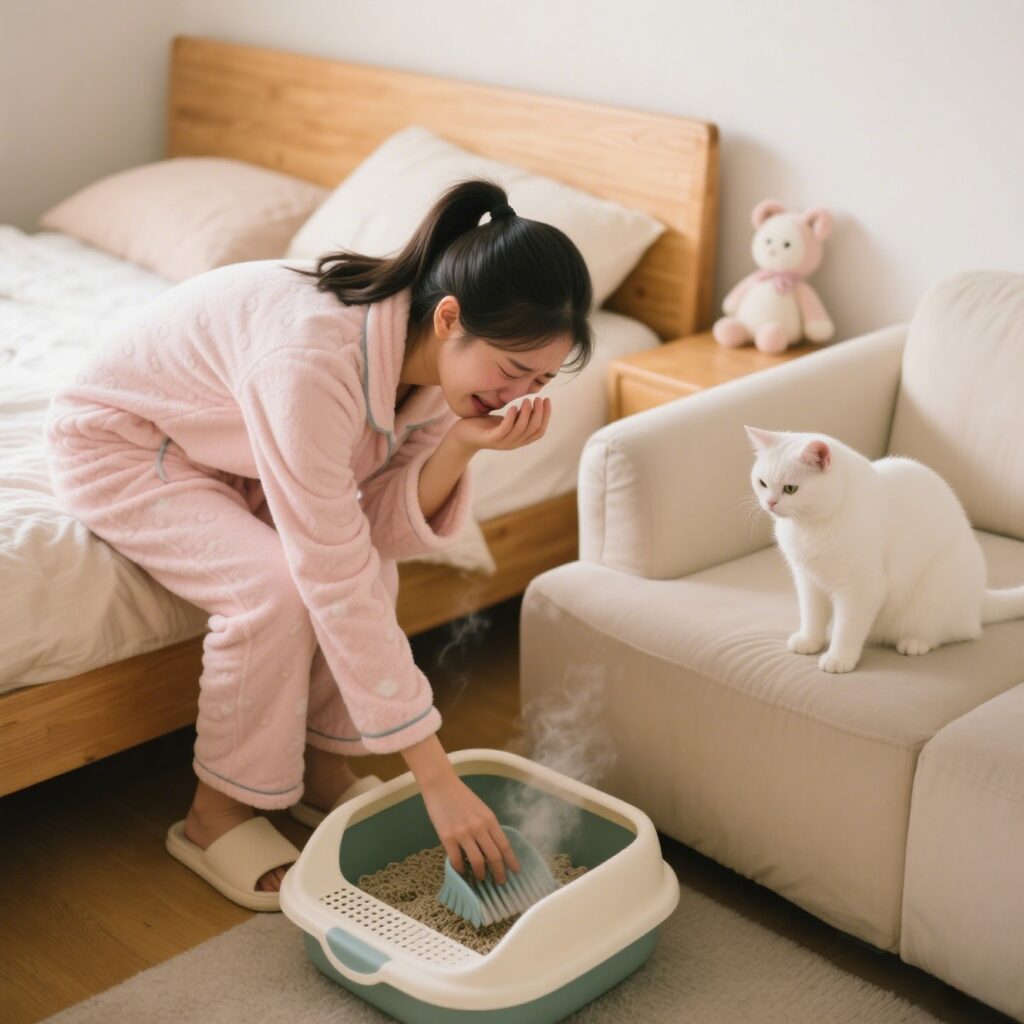
Now let’s talk about how the design of your litter box affects cleaning efficiency — because not all litter boxes are created equal! Different structure types come with varying levels of ease when it comes to that dreaded cleaning session.
| Design Type | Steps | Dead Spot Risk | Drying Time (mins) |
| Open-Top | 2 (Lift-out) | Low (no seams) | 2–3 |
| Flat-Scoop | 3 (Snap-release) | Medium (tracks) | 5–8 |
| Drum-Type | 5+ (Multi-axis) | High (mesh joints) | 10–15 |
| Step-In | 4 (Layered) | Medium (pedals) | 6–10 |
– Open-Top Litter Boxes:
– Steps: 2 (Lift-out)
– Dead Spot Risk: Low (thanks to no seams)
– Drying Time: A speedy 2–3 minutes
Open-top designs are champions at achieving 100% water coverage during rinsing, effectively minimizing any bacterial residues.
– Flat-Scoop Litter Boxes:
– Steps: 3 (Snap-release)
– Dead Spot Risk: Medium (due to tracks)
– Drying Time: 5–8 minutes
Flat-scoop styles might have a tad more complexity, but their snap-release steps make them pretty manageable for quick cleaning.
– Drum-Type Litter Boxes:
– Steps: 5+ (Multi-axis)
– Dead Spot Risk: High (because of mesh joints)
– Drying Time: 10–15 minutes
Drum designs might look fancy, but they often come with nooks and crannies that love holding grime. Beware those mesh seams that trap dirt unreachable by brushes, raising mold risk by about 45%.
– Step-In Litter Boxes:
– Steps: 4 (Layered)
– Dead Spot Risk: Medium (due to seams and pedals)
– Drying Time: 6–10 minutes
Step-in models in their layered glory have moderate cleanliness perks but require a bit more careful attention during maintenance.
Key Insights:
Open-top designs clearly lead the pack with their water coverage and minimal bacterial concerns, while drum types may look sleek but can become cleaning headaches. Knowing the cleaning efficiency of each structure type certainly helps in picking the right box to fit your needs and lifestyle.
And there you go! Whether your cat’s a gentle soul or a rambunctious rogue, there’s a smart litter box design perfect for your cleaning style. These thoughtful innovations promise to save you both time and manual labor, keeping your kitty’s space—and your home—sparkling clean.
Remember, a cleaner litter box means a happier kitty (and human), so consider these engineering marvels next time your duties call. Until next time, happy scooping!
Enclosed Device Dead Spot Solutions
Structural Optimization
When it comes to smart litter box design, addressing structural complexity is key to solving those pesky hygiene dead spots. A common issue with enclosed drum designs is that mesh and waste compartment gaps can become bacterial breeding grounds. They require disassembly of numerous parts, and it’s time-consuming. The solution? Structural optimization!
To optimize the structure, engineers have integrated escape hatches that double as rinse access points. These top openings, larger than 20x30cm, allow for direct water jet coverage, reducing grime accumulation. This feature ensures even the trickiest spots get a good clean, minimizing the need for intricate disassembly.
Additionally, the use of seamless molding eliminates mesh-wall gaps. This clever design feature prevents grime from accumulating in hard-to-reach areas, which traditional litter boxes often grapple with. By getting rid of these problematic seams entirely, the smart litter box maintains a much cleaner environment for our feline friends.
Electronics Protection
Protecting the electronics inside a smart litter box is another critical aspect of its design. With smart features comes the necessity to safeguard against water and litter damage. Nano-coated printed circuit boards (PCBs) offer a high level of protection, rated IPX6 waterproof, meaning they can withstand high-pressure rinsing without suffering damage.
Moreover, hydrophobic sensor seals, coated with a fluoride film, enhance the reliability of sensors. This clever engineering reduces the likelihood of false triggers by 90%, ensuring the smart features operate smoothly undisturbed by environmental factors. The combination of these protective measures ensures long-lasting functionality and reliability of the electronics, allowing them to withstand the trials of daily use.
User Scenarios & Maintenance Cycles
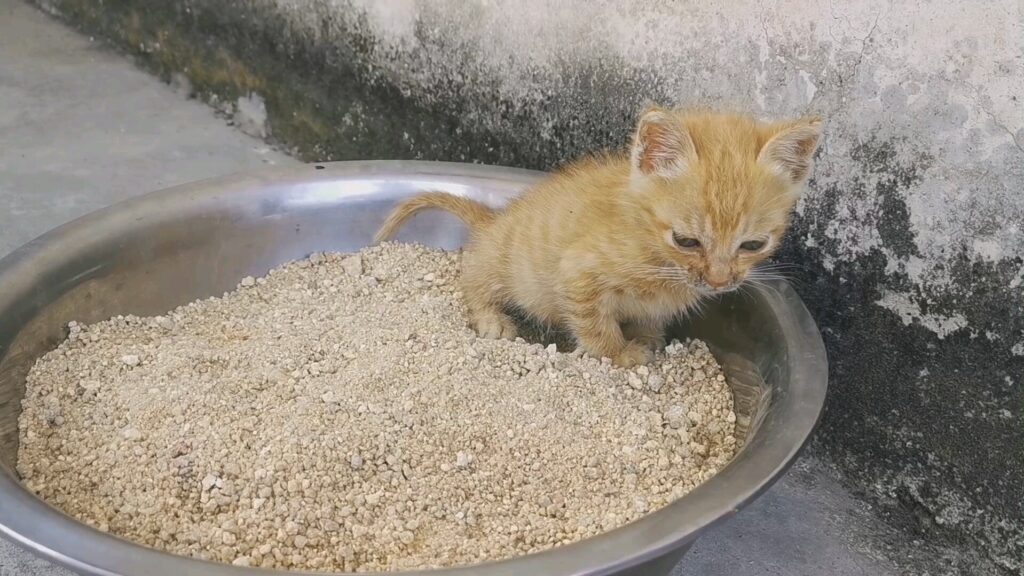
Multi-Cat High-Frequency Use
In homes with multiple cats, the frequency of litter box use skyrockets, posing additional challenges for maintenance. Fortunately, the engineering behind smart litter boxes has anticipated these scenarios. The key lies in the durability of the hydrophobic coatings applied to the box’s interior surfaces. These coatings maintain their effectiveness for 6 to 8 months, even with high-frequency use, ensuring that grime slides right off with each rinse.
Thanks to this hydrophobic technology, the cleaning frequency can be reduced to a weekly snap-rinse cycle, a stark improvement compared to the more frequent cleanings required by traditional litter boxes. This not only extends the coating’s lifespan but also provides owners with more time to enjoy with their pets, rather than obsessing over box maintenance.
Health-Sensitive Cats
When it comes to cats with health sensitivities, such as those prone to urinary tract infections (UTIs), the smart litter box’s design is especially beneficial. The antimicrobial properties of the zinc ion-infused coatings remain effective for up to 12 months. These coatings play a critical role in reducing the risk of UTIs by combating bacterial growth within the litter box.
For these health-sensitive kitties, the advanced antimicrobial treatment means fewer health concerns and more peace of mind for their owners. It’s a win-win situation where the litter box not only serves its fundamental purpose but also contributes to the overall well-being of the household’s pets.
In conclusion, the marriage of structural optimization and advanced material coatings with the strategic consideration of different user scenarios transforms the traditional labor-intensive litter box cleaning into a swift, efficient 10-minute process. Smart engineering solutions such as modular components, seamless molding, and protective coatings are not just innovative—they’re game changers in pet care. With continued advancements, smart litter boxes are poised to minimize human intervention, making them an indispensable part of pet owners’ lives. The smart litter box cleaning revolution truly respects our time and our furry friends’ well-being, ushering in a new era of convenience and hygiene.
Future Trends: Self-Cleaning Systems
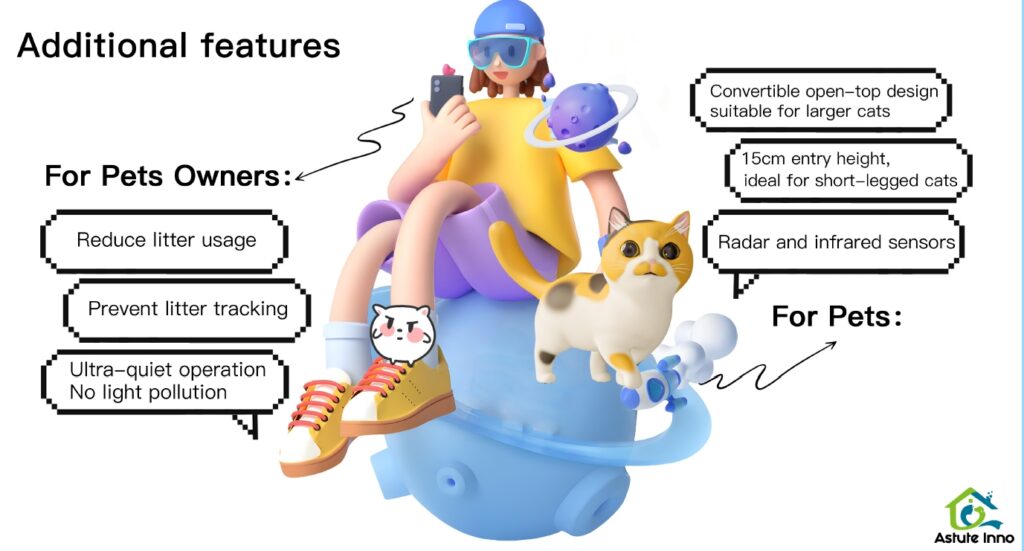
The future of litter box technology is paving the way for less human involvement and more intelligent operations that transform maintenance into a seamless part of your routine. Let’s dive into two fascinating trends that are revolutionizing the smart litter box industry, setting a new standard for what we can expect.
Photocatalytic Decomposition
Imagine a litter box that not only contains your cat’s waste but also works diligently while you and your feline friend sleep. This is where photocatalytic decomposition comes into play. Utilizing a coating of Titanium Dioxide (TiO₂) combined with UV LEDs, smart litter boxes can break down organic waste at a microscopic level. Think of it like having a tiny team of janitors working around the clock. The UV light activates the coating, which then decomposes organic materials, reducing the need to roll up your sleeves for frequent deep cleans. It’s like having a self-purifying kitty facility, saving you both time and elbow grease. This technology makes manual cleaning not just less frequent but practically effortless, leaving you more time to enjoy with your cat.
IoT Alerts
In an age where everything is getting smarter—from our phones to our homes—why shouldn’t litter boxes get in on the action? Enter the Internet of Things (IoT) and the sensors that power it. A game-changing feature in smart litter boxes, IoT-enabled grime sensors measure resistance changes within the box, making it possible to monitor cleanliness levels with striking precision. When the sensors detect grime building up, they send alerts directly to your smartphone. These reminders boast a less than 5% error rate, ensuring you are always one step ahead in maintaining the fresh environment your kitty deserves. So, forget surprises and stay informed with the tap of a screen!
The combination of photocatalytic decomposition and IoT alerts aims to streamline your litter box maintenance experience to an almost hands-off affair. These technologies represent a cornerstone of future smart litter boxes that prioritize user convenience and hygiene, opening a bright horizon where minimal human interference ensures maximum sanitary benefits. In this future, your role shifts from manual cleaner to a facilitator who only needs to oversee smart technology keeping your cat’s space pristine, contributing to your peace of mind and a healthier home environment.
Conclusion
In the ever-evolving world of smart litter boxes, a 10-minute deep clean is no longer a fantasy but a reality. Thanks to remarkable engineering feats, these devices now offer an outstanding balance of practical design, innovative materials, and streamlined processes. The structural revolution with tool-free snap-fits helps to eliminate complicated assemblies and hygiene dead spots. At the same time, biomimetic superhydrophobic coatings ensure longevity and minimize grime buildup. Plus, the modular design enables quick and simple cleaning tasks, such as rinsing, wiping, and air-drying.
This shift toward easy cleaning is not just about convenience—it’s about respecting user time. With future advancements, we can anticipate even less human intervention as self-cleaning mechanisms take hold, prioritizing a sanitary environment for our beloved pets. As these innovations continue to surface, smart litter boxes will likely shift the competition focus from flashy features to maximizing their hands-off capabilities, offering pet owners peace of mind and extra time in their day.
Visit our cat smart litter box for more information! And any comment are welcome: info@astuteinno.com.

